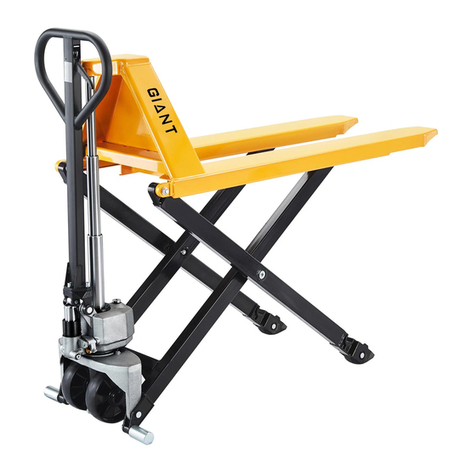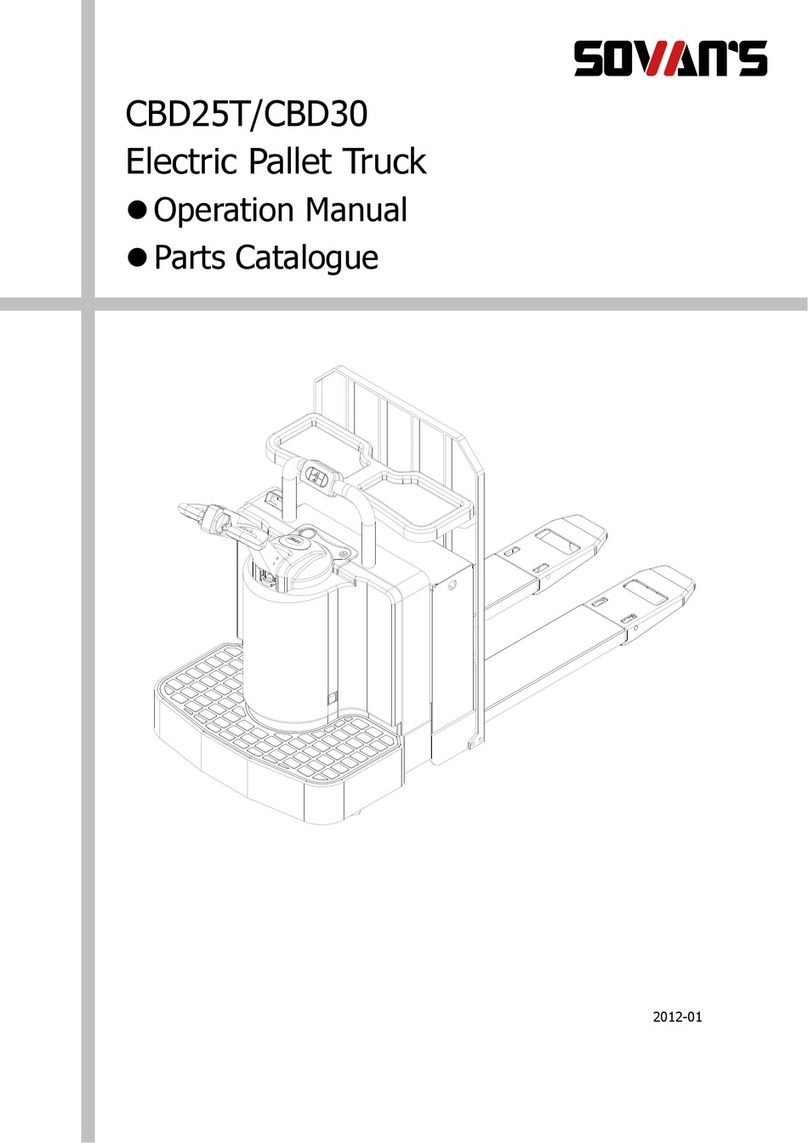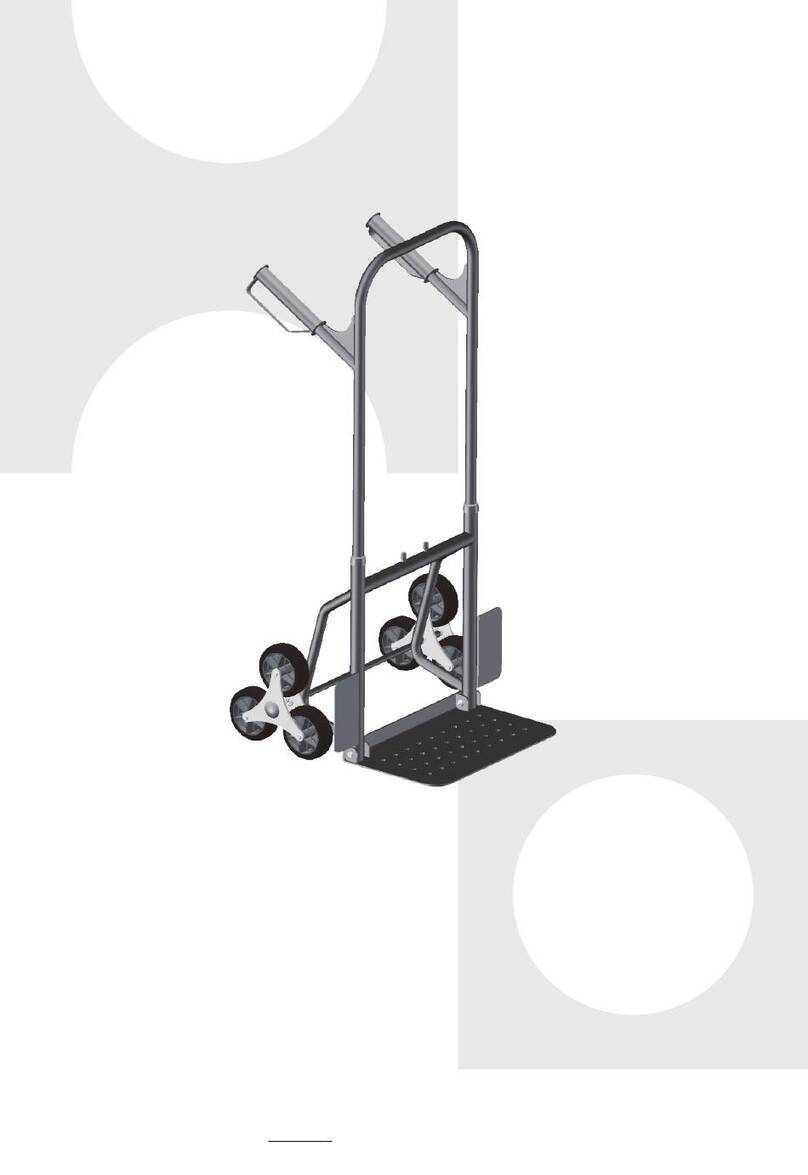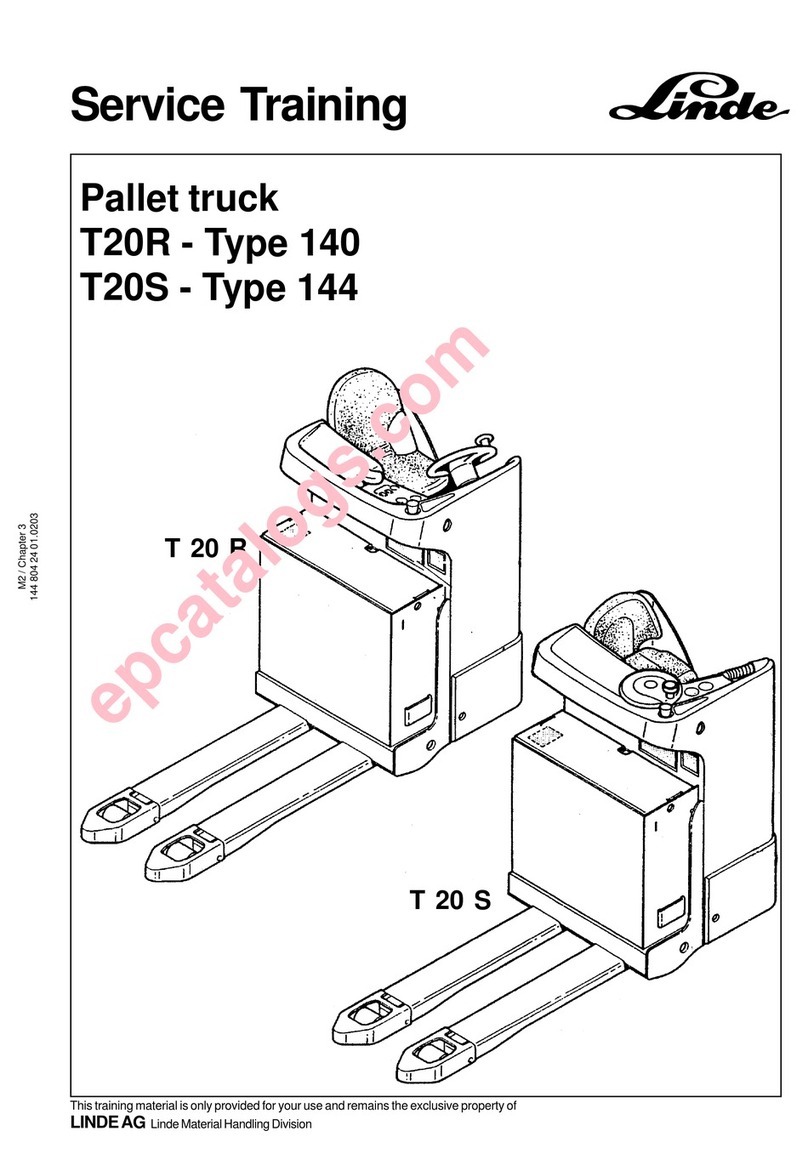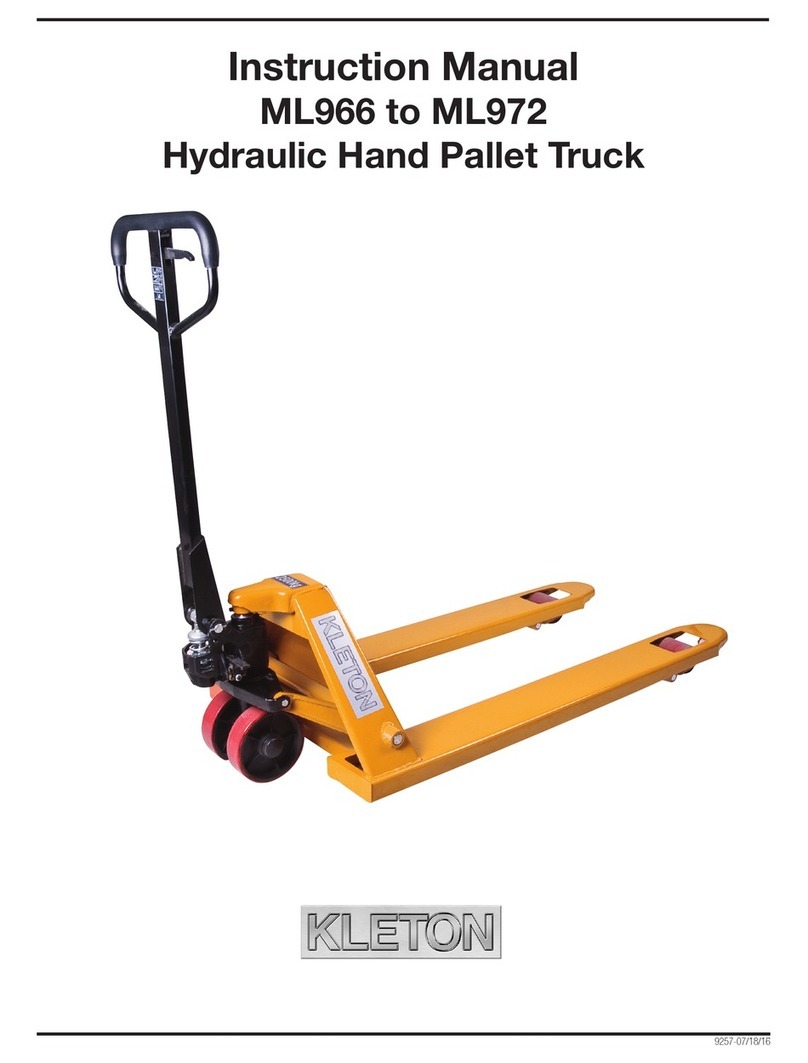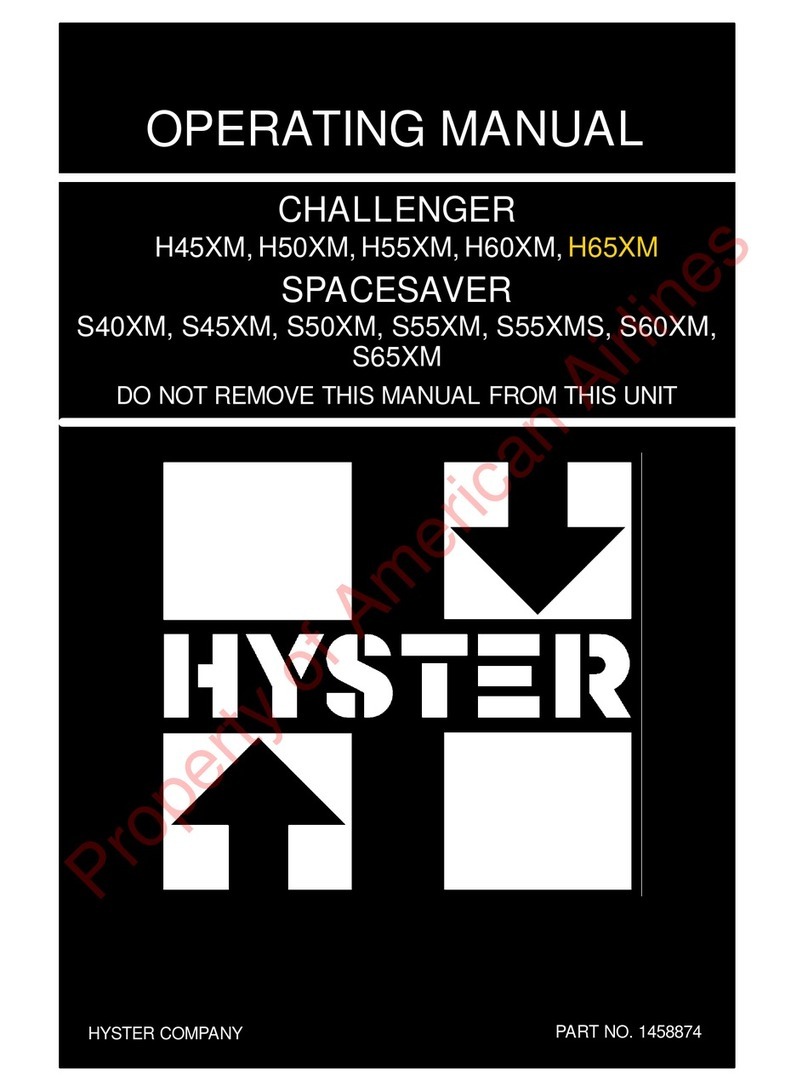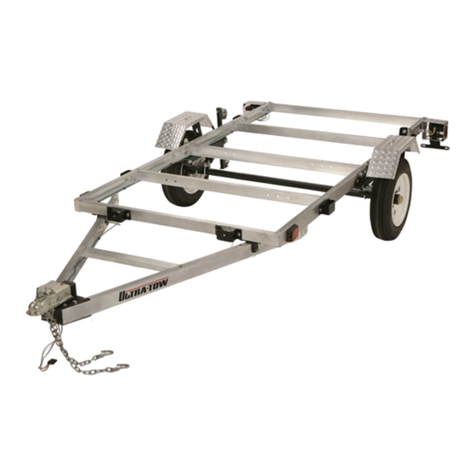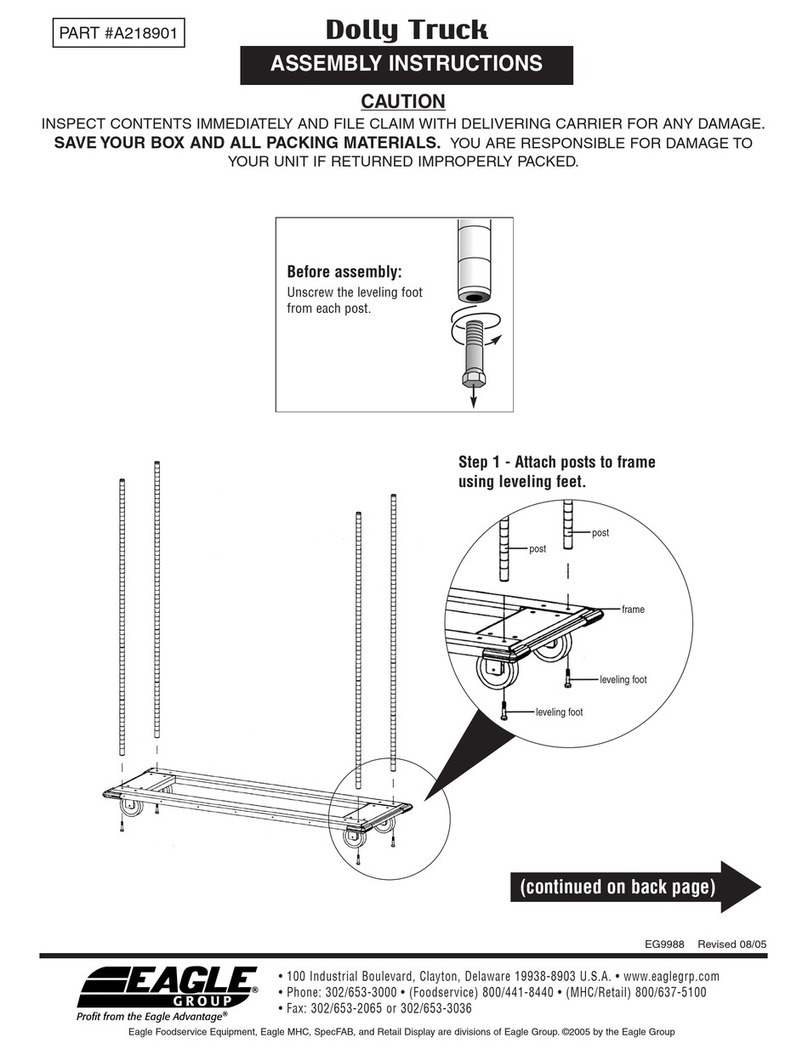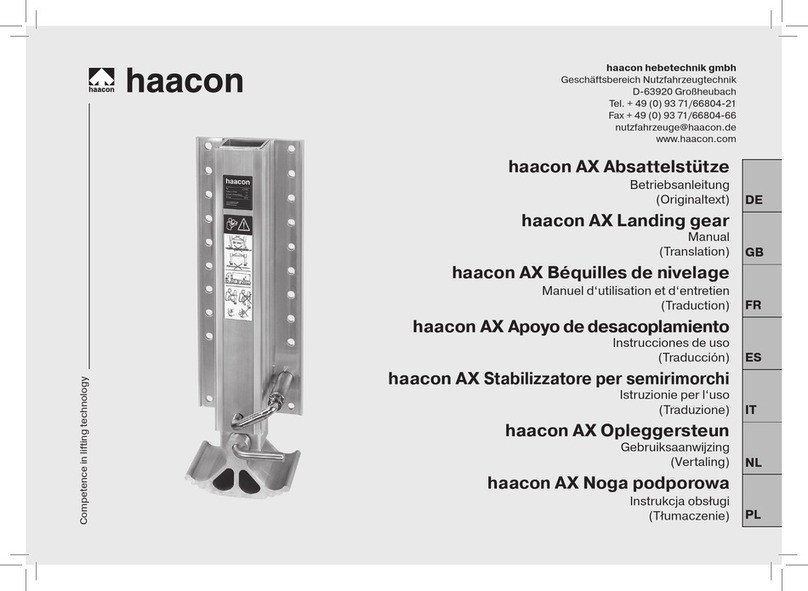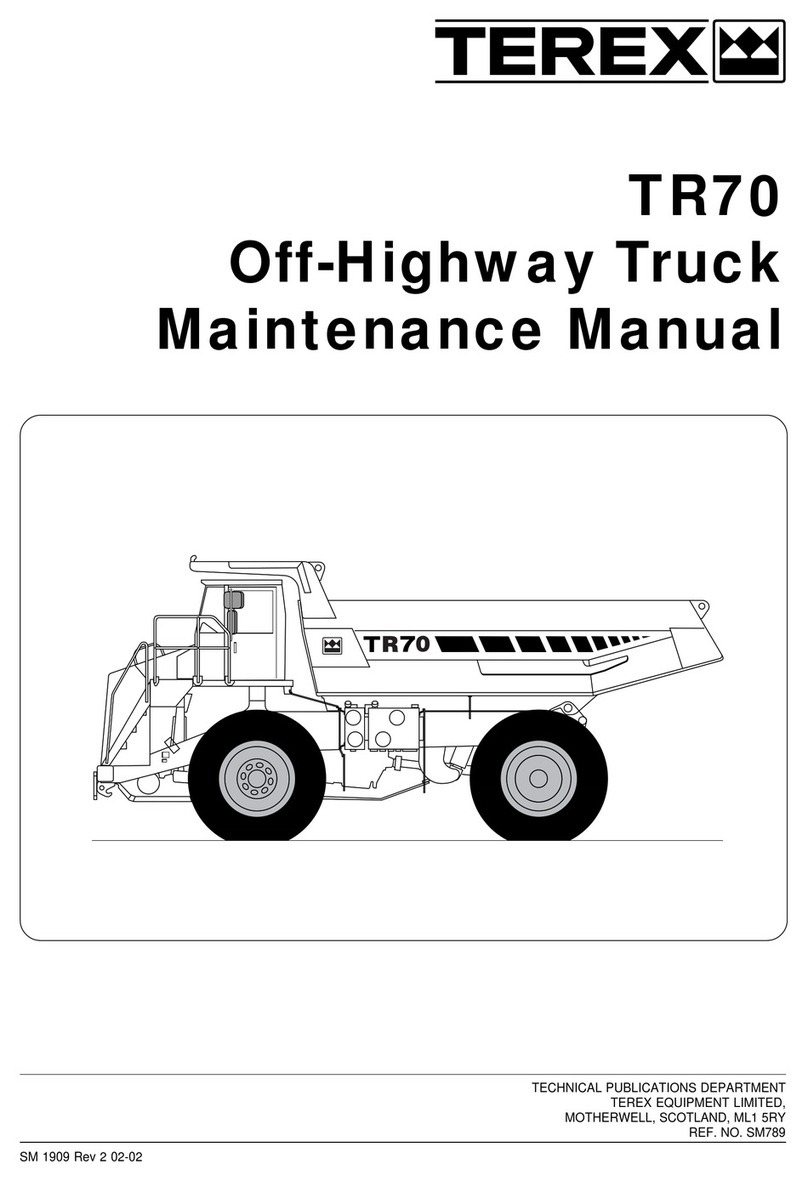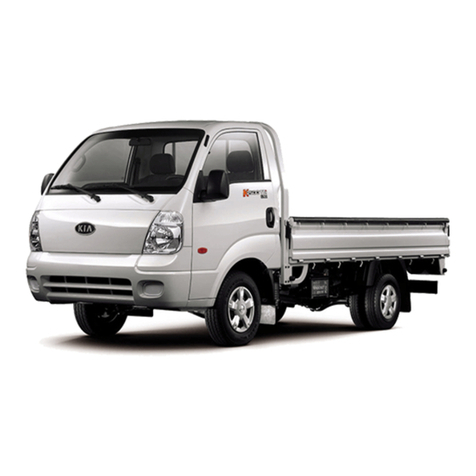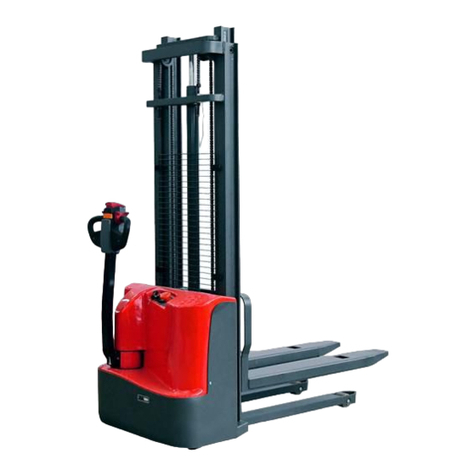Sovan's CTD10R-E User manual

CTD10R-E
Electric Pallet Stacker
Operation Manual
Parts Catalogue

1
We hope our electric stackers will bring great
convenience to your work!
⚫Please read the manual carefully before operation.
⚫This manual is a common manual. We reserve the right to modify
technology of the electric stacker. If there is anything in the
manual that is not consistent with the actual stacker, the actual
stacker should be considered correct and the manual is only for
reference.
************************************************************
Warning!
Operators must strictly conform to ISO3691 “Safety Specifications of Motor Industrial Vehicles”. Untrained
personnel are not allowed to operate the stacker.
************************************************************
According to ISO 3691 “Safety Specification of Motor Industrial Vehicles”, load capacity and lifting height of our
CDD Electric Pallet Stacker are stipulated as follows:
1.——When the lifting height of CTD10R-E stacker is below 2500mm (including2500mm), the
maximum load capacity is the rated capacity. Overloading is prohibited.
2.——When the lifting height of CTD10R-EIII stacker is above 2500mm (excluding2500mm), the
load capacity is less than the rated bearing capacity. Take the following diagrams as a reference
with the rated loads of 1000kg.
1.2T LOAD CHART
400g
1200kg
1000kg
800kg
600g
mm
6 0 0 8 0 07 0 0 900
3 3 0 0 m m
3500 mm
1000
1.2T Load Chart

2
Table of Contents
1.Outline drawing and main technical parameter………………………………1
2.Brief introduction of structure………………………………………………...3
3.Safety specifications……………………………………..……….…………….3
4.Initial operation……………………………………………………………….….8
5.Use and operation instruction…………………………………………….….9
6.Use, maintenance and charging of storage battery……………….…..12
7.Inspection before operation……………………………………..………….14
8.Inspection after operation………………………………………..………….14
9.Periodic maintenance and upkeep………………………………………….15
10. Storage, transportation, and loading&unloading……………………….19
11.Replacement of storage battery……………………………….............20
12.Common faults and troublshooting………………………...…………..20
13.Common faults signal and trouble shooting…………………………..23
14.Lists of accessories, spare parts and vulnerable parts.……………..25
15.Structure and principle diagrams of major parts…….……………….25
16.Packing list………………………………….……………….…………………28
Appendix I Safety Specifications of Motor Industrial Vehicles….………29

3
Appendix:《 Safety Specifications of Motor Industrial Vehicles》
Brief introduction:
CDDR electric pallet stacker adopts storage batteries as the dynamic source and a AC motor as the driving
force, traveling through gear transmission. The lifting of the fork relies on the DC motor and the hydraulic
transmission system. The up-and-down movement of the oil cylinders lifts the fork and the goods. As the
traveling and lifting of the stacker are electrically driven, it possesses the characteristics of energy saving,
high efficiency, stable operation, easy operation, safety and reliability, low noise and no pollution, etc.This
stacker adopts 24V storage battery, which greaty prolongs use time after one charging.
The stacker is applicable for goods piling and handling on hard and flat ground.
Allowed environment for using:
a. Height above sea level shall not be over 1000m;
b. Ambient temperature shall not be higher than +40℃and no lower than -25℃;
c. When the ambient temperature reaches +40℃, the relative humidity should not exceed 50%; at a
lower temperature, higher relative humidity is allowed.
d. Hard and flat ground
e. It is prohibited to use the stacker in a flammable, explosive or corrosive environment with acid and
alkali.
Description:
The instruction manual shall be kept by the operator, and shall be read by the operator until he gets a full
understanding.
The instruction manual is composed of correct operation, convenient and simple maintenance, and routine
inspection.
The instruction manual shall be carefully read before operation, for purpose of correct drive and suitable
maintenance to ensure safe and effective material transportation.
The instruction may be in disagreement with practical product due to product innovation.
The instruction manual shall be accompanied with in case of truck leasing or transfer.
Please come into contact with our sales department in case of any problem.
Description of symbol:Regulations of the following symbols are of great importance to your safety and others
as well.
Please observe these regulations:
Danger
Indicates an impending danger. Deaths or severe injuries
would be resulted without any precaution or avoidance. You
must observe those requirements.
Warning
Indicates a potential danger. Deaths or severe injuries would
be resulted without any precaution or avoidance. You must
observe those requirements.
Caution
Indicates a potential danger. Moderate injuries would be
resulted without any precaution or avoidance. You must
observe those requirements.

4
Notice
You shall pay attention to statements that are in direct or
indirect relation with personal security and truck maintenance.

1
1. Outline drawing
1.1 CTD10R-E Outline drawing

2
CTD12R-E Electric Pallet Stacker
Characteristics
1.1
Manufacturer(abbreviated)
1.2
Model
CTD10R-E
1.3
Driving model:
diesel, gasoline, fuel gas
Electric(Storage battery),
1.4
Driving model(Manual, Walking, Stand driving,
Seat driving ,Order picking)
Walking
1.5
Rated load
Q(kg)
1000
1.6
Load center distance
c
(mm)
600
1.7
Front overhang
x
(mm)
790
1.8
Tread
Y
(mm)
1280
Weight
2.1
Service weight(with battery)
kg
720
2.2
Axle load, front/rear, laden
kg
545/1055
2.3
Axle load, front/rear, unladen
kg
515/205
Wheel chassis
3.1
Wheels (rubber, high elasticity, pneumatic tyre,
polyurethane wheel)
Pu
3.2
Wheel dimension, front
φ195×70
3.3
Wheel dimension, rear
φ98×82
3.4
Additional wheel(dimension)
φ150×60
3.5
Wheel number, front/rear (x = driving wheel)
1x+1/4
3.6
Tread, front
b
10(mm)
523
3.7
Tread, rear
b
11(mm)
1016-1416
Dimension
4.1
Height of mast, lowered
h
1(mm)
2030/1780/2030
4.2
Lift height
h
3(mm)
1600/2500/3000
4.3
Max. height of mast, extended
h
4(mm)
2030/3000/3500
4.4
Min. /Max. height of operation handle, in driving
position
h
14(mm)
670/1300
4.5
Height, lowered
h
13(mm)
80
4.6
Overall length
l
1(mm)
1720
1800
4.7
Length to fork face
l
2(mm)
651
4.8
Overall width of truck body
b
1(mm)
1132-1532
4.9
Fork dimension
s/e/l(m
m)
40/100/1070(1150)
4.10
Overall width of fork
b
5(mm)
200-800
4.11
Wheelbase ground distance
m
2(mm)
35
4.12
Aisle width, with pallet 1000x1200 crosswise
Ast
(mm)
2410
4.13
Aisle width, with pallet 800x1200 lengthwise
Ast
(mm)
2280
4.14
Turning radius
W
a(mm)
1490
Performance
Data
5.1
Traveling speed, laden/unladen
Km/h
4.5/5
5.2
Lifting speed, laden/unladen
m/s
0.07/0.09
5.3
Descending speed, laden/ unladen
m/s
0.09/0.08
5.4
Max. gradeability, laden/unladen
%
6/15
5.5
Traveling brake
Electric brake
Motor
6.1
Driving motor power
kW
0.65
6.2
Lifting motor power
kW
2.2
6.3
Battery voltage/rated capacity
V/Ah
24/105 24/125
6.4
Battery weight
kg
60.8
6.5
Battery dimension(LXWXH)
mm
260X168X212 329×172×214
7.1
Noise level at operator’s ear, according to
DIN12053
dB(A)
70

3
2.Brief introduction of structure (See also the structure diagram
and the principle diagram of the major parts)
The stacker mainly consists of frame, mast, fork, lifting oil cylinder, operation handle, steering device,
driving wheel, storage battery pack, hydraulic power unit and control system for electrical equipment, etc.
3. Safety Norms:
Warning:
Please pay attention to the following items first before operation of the truck:
1) This electric truck is only limited to utilization indoor with a hard flat floor. Operation in inflammable,
explosive environment or corrosive environment such as acid or alkaline condition shall be strictly
forbidden.
2) Only drivers who have received formal training or are authorized can be allowed to drive the truck.
3) Read this instruction carefully before operation so as to master the performance of the stacker; check the
truck whether it is in its normal condition before each operation. It is forbidden to use faulty stacker;
repair by untrained persons is forbidden as well.
4) Overloading operation is forbidden.
5) As for goods carrying and operation, center of gravity of the goods must be within range of the two forks.
It is forbidden to transport loose goods
6) The truck shall travels slowly when forks pass in or out of pallet.
7) It is strictly forbidden to press the lifting or lowering button during the traveling of the truck. Meanwhile,
don’t switch lifting and lowering buttons rapidly or frequently, because rapid and frequent lifting or
lowering will cause damage to the truck and goods.
8) Don’t load heavy goods on the forks rapidly.
9) Don’t lay the goods on the truck for a long time!
10) It is strictly forbidden to make sharp turn on narrow aisle. When it is turning, slow down the truck so as to
ensure the safety of personnel and goods.
11) Descend the forks to the lowest position when the truck is not used.
12) It is strictly forbidden to put any part of the body under heavy goods and forks.
13) This truck is suitable to be used on flat ground or flat platform. Don’t put the truck on the slope for a long
time.
14) Overloading operation is forbidden. Otherwise the wheel will skid, resulting in the damage of wheel and
motor as well as danger of the human body and goods.
15) It is strictly to use the truck under stipulated voltage of 20.4V.
16) It is strictly forbidden to conduct charge by connecting the plug to AC power directly.
⑴It is forbidden to operate the stacker when the lift height of fork exceeds 500mm.
3.1Safety operation norms:
⑴Training of driver:
Notice
Even though each electric pallet stacker may have the same technical parameters, there may
be differences on features of braking and acceleration as well. Never drive the truck until you get
familiar with all those operations.

4
⑵Wear of the driver during truck driving:
Notice
Please put on safety shoes and protective clothes. Do not wear clothes that are too loose
for sake of being caught, which would result in danger.
⑶Rules that must be observed:
Notice
Never drive the truck when you are tired or un-concentrated, with an injection of drug, or
after a liquor drinking.
Safety rules and regulations shall be observed during operation or maintenance of the truck.
⑷Safety of working place:
Notice
This kind of electric stacker is only limited to utilization indoor with a hard flat floor.
Operation in inflammable, explosive environment or corrosive environment such as acid or alkaline
condition shall be strictly forbidden.
a. Good roadway condition shall be kept and the traffic should be smooth.
b. Sufficient light ray shall be ensured on working place.
c. Fire extinguishing appliances shall be equipped in the places where truck and charging is operated.
The extinguishing appliances shall comply with the requirements of extinguishing fire of solid combustible
matter and electric apparatus.
d. The value of truck noise mentioned in instruction is measured under the condition of new truck running on
flat, smooth and hard ground. If the traffic surface is bad or the tyre of truck is damaged, the noise may
be amplified.
⑸Integrity of the truck shall be realized:
Warning
Do not make modifications on the truck.
APlease observe safety rules and regulations of your working place during operation, inspection, and
maintenance of the truck.
- Unauthorized truck modification is not permitted.
- No modifications or alterations to a powered industrial truck, which may affect, for example, capacity,
stability or safety requirements of the truck, shall be made without the prior written approval of the
original truck manufacturer, its authorized representative, or a successor thereof. This includes
changes affecting, for example braking, steering, visibility and the addition of removable
attachments. When the manufacturer or its successor approve a modification or alteration, they shall
also make and approve appropriate changes to capacity plate, decals, tags and operation and

5
maintenance handbooks.
- Only in the event that the truck manufacturer is no longer in business and there is no successor in the
interest to the business, the user may arrange for a modification or alteration to a powered industrial
truck, provided, however, that the user shall:
a) arrange for the modification or alteration to be designed, tested and implemented by an
engineer(s) expert in industrial trucks and their safety;
b) maintain a permanent record of the design, test(s) and implementation of the modification or
alteration;
c) approve and make appropriate changes to the capacity plate(s), decals, tags and instruction
handbook;
d) affix a permanent and readily visible label to the truck stating the manner in which the truck has
been modified or altered together with the date of the modification or alteration, and the name and
address of the organisation that accomplished the tasks.
⑹Prepare safety operation procedure:
Safety operation procedure shall be formulated with consideration of practical situations before
operation of the truck. Safety shall be taken into full consideration in preparation of the safety
operation procedure.
⑺Operation of truck under unsafe condition is strictly forbidden:
a. Operation under unsafe condition is forbidden, such as under conditions with uneven floor, or
impeded road. Goods lifting on slope is strictly forbidden.
b. Faulty truck is forbidden to use.
c. Make sure a daily inspection of the truck would be taken. Please immediately repair or replace in case of
any abnormal conditions.
⑻Overloading operation of truck is forbidden:
Warning
Overloading operation of truck is forbidden. Overloading operation would
cause damage to the truck or bring harm to operator.
⑼Use suitable pallet:
The pallet shall be of suitable dimensions, neither too wide nor too large.
⑽Electrical system check:
Notice
Before checking the electrical system, turn off the key switches and the
emergency isolation switches.
3.2 Safety Operation Specification:
⑴Check the safety condition around the truck:
Notice
Before starting up the truck, please ensure that there is no person around it.

6
Notice
If the driver’s view is shielded by the bulky goods carried, please drive
backwards or drive under the guidance of other working personnel.
Notice
Ensure no people around the truck when driving backwards.
Notice
Driving through the narrow access shall be guided by working personnel.
Notice
At crossroad or other places impeditive for view, the driver shall not drive until there
is no person at both sides.
Notice
Keep concentration when operating truck.
Caution
The driving mechanism of truck is installed on the foreside. Due to this
difference from common vehicles, the foreside of truck swings comparatively fast
when turning around. For this reason, to prevent collision with other objects nearby
the foreside of truck, do drive or turn slowly.
⑵Strictly forbid harsh driving
Notice
Never start up, brake or turn abruptly.
Abrupt start-up or braking may cause the falling of goods.

7
⚫Abrupt turning during traveling may cause the tilting of truck and result in
serious accident. Do decelerate and take care to turn.
Notice
Observe all items of safety rules on working place. Decelerate and sound horn
when travel by other truck or vehicles. Avoid driving in places with bad view.
Notice
Ensure to provide certain clearance between truck and entrance.
(3)Never drive too close to roadside.
Notice
Ensure to provide enough distance between the truck and roadside or platform
edge.
When running on narrow road or platform, keep a certain safety distance with the edge against
falling of the truck.
Warning
Avoid turning or loading and unloading operation on slope;
otherwise the truck can go tilting.
3.3 Operation norms:
Notice
The truck can only carry goods under rated capacity.
1) Forbid overloading operation.
2) Forbid deflective transportation.
3) Passengers on truck must be forbidden.
4) Never push or pull the handle abruptly
5) Never use the truck as towing vehicle.
6) When transporting over-wide goods, the driver shall be extremely careful to turn slowly to keep balance of
the goods. Decelerate when ascent and descent, meanwhile, watch around for sake of safety.
7) The faulty truck for future repair must not be parked at places impeditive for traffic. Lower down the fork
arms to the lowest position and put on the warning board. Pull off the key.
8) When protective devices suck as protective cover of mast is not mounted, it is forbidden to operate the
truck.
9) Take care to avoid the danger of wind force when loading goods.
Notice
Take care to avoid the danger of wind force when loading goods.
10)The operator shall master the traveling speed according to site condition.The truck shall slow down and

8
move at a low speed when turning, at a narrow aisle, passing by swing doors or places where view impeded.
And the truck shall keep enough distance with the forklift moving forward. Abrupt stop, sharp turn and
overtaking are forbidden at dangerous places or where view is impeded except accidents. It is forbidden hold
body or hands out of the driving cabin.
11)Driver’s view during operation: The driver’s view must keep in the traveling direction of the stacker and pay
attention to the condition on driving roads at all times. If the goods carried impeding driver’s view, goods
carried must be adjusted to the backward of driver’s view. If the goods can not be adjusted, another operator
shall be arranged and walk by the stacker so as to report the forward road condition for the truck driver.
12)Upgrade or downgrade driving: The route of upgrade and downsgrade shall be specified driving roads. The
ground shall be kept clean, safe and reliable in accordance with technical performance
of the stacker. When the truck is moving upgrade with goods, the forks should be kept in the forward position.
While drving downsgrade, the stacker shall move backward. Turning, tilting
driving and parking is not allowed during upgrade and downsgrade moving. Make sure to slow down when
downgrade drving and always make prepare for braking.
13)Driving the stacker to elevator or charging platform: When it is necessary to drive the stacker to elevator
or charging platform, make sure that elevator or charging platform has enough loading capacity, with the
design structure applicable for bearing stacker. Meanwhile the elevator and charging platform should be
permitted by the equipment user. Checks must be carried out before operation. Before driving into the elevator,
the goods should be carried into the elevator first and select the suitable parking space for the truck in order to
avoid collision with walls during lifting. When there is other person needs to use the elevator, they should place
the stacker at first.Then they can come into the elevator afterwards. When the elevator reaches the specified
height, the personnel shall get out of the elevator at first.
14)Conditions for goods to be transported: The stackor operator should checke the goods carefully make sure
that there is not any risk. Before transportation of the goods, place and locate the goods. If there is any
possibility of falling or overturning of the goods during transportation, it should be mounted with
protective devices (such as protective guard).
3.4 Important notice after operation:
1)Parking: Park the truck at appointed place. Never park the truck on slope.
Ensure the following points to be achieved before leaving away the truck:
a. Lay down the fork to the lowest position naturally.
b. Turn the steering wheel to the middle position.
c. Turn off the key switch.
2)Clean up the truck:
Notice
When cleaning up the electrical system, use compressed air but not
water.
3)Charge:
Warning
Open flame is forbidden to appear at the charge places, otherwise,
explosion or fire disaster can be caused.
Make a record of charge. As for the charge method, refer to the part about storage battery
operation.

9
4.Initial operation
4.1 Initial operation:
4.1.1 In case of dangerous conditions, the power can be cut off, and the battery plug must be connected to
the emergency parking plug of the stacker itself.
Warning
It is strictly forbiddent to operate the stacker without emergency
parking plug.
4.1.2 The stacker can only be driven by the battery power, but without rectified AC current which may
damage the electric parts of the truck. And length of battery cable (tow cable
) shall not be over 6m.
4.1.3If the stacker is driven by the external battery through a tow cable, it is forbidden to lift the loads.
4.1.4Befor initial operation of the stacker, checks must be carried out as follows:
a) Check that whether the device is complete or whether the status is normal.
b)If the stacker has not been mounted with battery, it must be mounted with battery. Take care not to
damage the battery cable.
4.1.5The feature curve of charger shall be adjusted(charging curve).
4.1.6 If the truck is not used for a long time, wheels placed on the ground will be pressed. Only after the
truck is put into operation for a short time, the wheel can come to the original shape.
4.2 Drive of the stacker without the driver of the stacker itself:
Warning
It is strictly forbidden to drag the stacker on the slope.
4.2.1 In case of dragging stacker during emergency operation, the electromagnetic brake must be
loosened.
4.2.2 When the stacker is placed at a specified place, the electromagnetic brake must be relocated so as
to make the stacker in a state of brake.
5.Use and operation instruction
The electric pallet stacker adopts storage batteries as the dynamic source for short distance goods handling
and stacking. Correct use and operation will bring great convenience to your work but incorrect use and
operation will damage the stacker or pose risk to you and your goods.
5.1Before operation:
Warning
It is strictly forbidden to use faulty truck.
5.1.1 Before operation, please check if the truck is in normal condition: Is there any oil leakage in the
hydraulic pipes? Are the supporting wheels able to operate normally? Is there any block? The trucks
with problems are prohibited for operation.
5.1.2 Check if there is any electric power in the batteries with the method indicated in Fig.I. Pull the general
power switch out to turn on the general power supply, unlock the electric lock on the handle, check

10
the electric energy meter on the instrument panel of the truck. If the zero end grid is bright, it
indicates there is no electric power in the batteries and charging should be conducted at once. It is
prohibited to operate the truck without electric power as that will greatly reduce the service life of the
batteries and even damage the batteries.
5.1.3 Check if the truck brake is normal. Check the lifting, dropping, forward and backward traveling of the
truck to see if the actions are normal. Check if the emergency reverse action of the truck is normal with the
method indicated in Fig.II:
Warning
It is strictly forbidden to turn the accelerator knob fastly to speed up
the stacker abruptly during goods transportation.
Move the control handle to division A or division C as indicated in Fig.II and press the rise/lowering button on
th control handle to see if the lifting and lowering of the fork is normal. Then turn the control handle to
division B as indicated in Fig. II, slowly start the truck and press the handle to the horizontal position to
check that whether the truck can travel and brake normally.
Move the control handle to division B as indicated in Fig.II, press the emergency reverse button on top of the
control handle to ckeck that whether the truck can travel backward normally.

11
After the above check, if there is no failure in the truck, it can be put into operation; if there is some failure,
please repair it at once. It is prohibited to use trucks with problems.
5.2 In operation:
5.2.1
Accelerator knob: The accelerator knob is used for controlling traveling direction and speed of the stacker.
When it is for the traveling operation, turn the operation handle to B area indicated in the above diagram.
When the handle is in A or C area, the stacker is in a power-off status, and can not travel. When the
operation handle is in B area and the accelerator knob is turned in one direction, the stacker wil travel in that
direction. While the accelerator is turned in another direction, the stacker will travel in another direction.
Meanwhile the bigger the turning amplitude is, the faster the truck will travel.
Note: A side-magnetic brake is installed on the shaft end of the driving wheel motor and there is a cam and
an inching switch installed on the rotary shaft of the rotary arm. Only when the rotary arm is at 45°±35°(as
indicated in Fig. II), the stacker can be turned on and travel. Larger or less than the angle, the stacker will be
powered-off and braked. In that case, the stacker can lift goods. When lifting goods, the stacker cannot
travel. As indicated in Fig. II, when the operation handle is in division A or division C, the stacker can only lift or
lower but not travel; when the control handle is in division B, the stacker can travel as well as lift or lower. The
operation position of the handle will not be specially described in the following descriptions, i.e. the stacker can
only lift or lower but not travel when the handle is in division A or C and the handle must be in division B when
the stacker is traveling.
5.2.2 As indicated in Fig. II, there is a button on the operation handle which is used for slowing down the
stacker. When this “slow down” button is pressed as well as accelerate knob is turned, the stacker will travel at
a low speed. This state is best suitable for turning a corner, stacking and moving into and out of the shelf while
taking goods. When the “slow down” button is released and the accelerate knob is turned, the stacker will travel
at a normal speed.
5.2.3 Safety height:
The safety lift height for mast is about 1.8m (according to the assembled mast): If the mast is lifted to a
height which is over the safety height, the stacker will slow down to about 3km/h.
5.2.4 Operation of handling and stacking:
Notice
Please check the following items before operation of the stacker:
Ensure no goods falling and goods damaged at loading and unloading area.
Ensure no goods or objects impeding for safety.
As indicated in Fig. II, pull out the general power supply switch, unlock the electric door lock, and drive the
stacker to the goods pile nearby. (The tip of the fork is 300mm from the goods pile). Press the lowering button,
adjust the height of the fork to a proper position, and insert the fork slowly and as deep as possible into the
pallet of the goods. Press the lifting button till the fork is 200-300mm from the ground. Drive the stacker to the
location of the goods shelf and stop slowly. (The tip of the fork is 300mm from the goods shelf.) Press the lifting
button and the fork rises to a proper height with the shelf (The bottom of the pallet is about 100mm higher than
the goods shelf). Move the goods slowly to the accurate position of the shelf and press the lowering button to

12
put the goods carefully on the shelf. Take the fork away from the goods and drive the stacker slowly to make the
fork out of the goods pallet. (The tip of the fork is 300mm from the goods shelf.) Lower the fork until it is
300mm from the ground and drive the stacker away from the shelf. Attention should be paid to that there
should be no obstacles around and when turning, the speed should be reduced.
Caution
The driving mechanism of truck is installed on the foreside. Due to this
difference from common vehicles, the foreside of truck swings comparatively fast
when turning around. For this reason, to prevent collision with other objects nearby
the foreside of truck, do drive or turn slowly.
5.2.5 Operation of taking goods off the goods shelves:
As indicated in Fig. II, pull out the general power supply switch, unlock the electric door lock, and drive the
stacker to the goods shelf nearby. (The tip of the fork is 300mm from the goods shelf). Press the lowering button,
adjust the height of the fork to a proper position, and insert the fork slowly and as deep as possible into the pallet
of the goods. Press the lifting button to lift the goods till the bottom of the pallet is 100mm from the goods shelf.
Slowly drive the stacker and slowly move the goods out of the shelf (the tip of the fork is 300mm from the goods
shelf). Press the lowering button and the fork lowers to a height of 200-300mm from the ground. Drive the
stacker away from the goods shelf until it reaches a desired position and then slowly stop it. Press the lowering
button to put down the goods, make the fork completely away from the goods and move the fork slowly out of
the goods pallet.
5.3 Abnormal situation handling during operation:
5.3.1When pressing the lifting button, the fork can rise but when releasing the lifting button, the fork is still
rising. The stacker is in a situation of out of lifting control. In that case, turn off the general power supply switch
to cut off the power supply at once. Drive the stacker to a safe position to lower the fork manually and repair the
circuit of the stacker.
5.3.2 If the brake is out of function when the stacker is in operation, the operation must be stopped at once and
repair the stacker.
5.3.3 When the stacker is moving forward and pushing the operator against a wall or other objects, press
the emergency reverse button on top of the operation handle and the stacker will automatically move backward
to avoid injuring the operator.
5.4 After operation:
After operation, the stacker should be parked in a fixed parking position and routine maintenance should be
conducted according to the stipulations in clause 6 and charging should be carried out.
6.Use, maintenance and charge of the storage batteries
Charging operation methods: This stacker is equipped with a fixed charger. And other built-in chargers are
also optional. When the fixed charger is used for charging, first open the side door to pull out the socket
connector to insert it into the socket joint of the fixed charger. Then insert the plug of fixed charger into two
phase AC power. Finally the charger will start charging after several seconds. When the built-in charger is used
for charging, first open the cover of battery case to take the charging plug out of the battery case, then insert
the charging plug into the two phase AC power. And the charging will start after several seconds.

13
6.1 Initial charge
6.1.1 Initial charge should be conducted for batteries that have never been used
6.2 Use and maintenance
6.2.1 In order to guarantee the service life of the batteries, the batteries in use should be fully charged.
Insufficiently charged batteries must not be used. During the process of use, close attention should be paid to
the discharge extent. Over discharge is prohibited.
6.2.2The batteries in normal use should avoid over-charge, but over-charge must be properly conducted for
the batteries in following situations, i.e. equalizing charge.
a. The “lag-behind” batteries--- batteries with a voltage lower than that of the other batteries in the
discharging process and the batteries having been repaired for failure. (When equalizing charge is
conducted, the positive and negative poles of the “lag-behind” battery should be respectively
connected with the positive and negative ends of the charger, the DC power supply, and the charge
should be conducted independently.)
b. Equalizing charge should be conducted for the batteries in normal use every 2-3 months.
c. Equalizing charge should be conducted for the batteries that have not been used for a long period of
time before use.
6.3 Storage
Batteries should be stored in a clean, dry and well ventilated warehouse with a temperature of 5-40℃. The
valid shelf life is 2 years. The batteries should be kept according to the following requirements during storage:
a. No direct sunshine on the batteries and at least 2m away from heat source.
b. Avoid contacting with any harmful substances. No metallic matters are allowed to drop into the
batteries.
c. The batteries should not be placed upright down and should not be impacted mechanically or
heavily compressed.
The batteries must not be stored with electrolytic solution. When it is required in special situation that the
batteries must be stored with electrolytic solution, the batteries should be fully charged and the density
and the liquid surface of the electrolytic solution should be adjusted to the stipulated values. When the
storage period comes to one month, the batteries should be complementarily charged with the
common charge method.
6.4 Charger
If the charger you use is full automatic type. It must meet with the following 2 requirements:
a. The output voltage of charger: 24V
b. The output current of charger: 30A
Warning
There is hydrogen gas accumulated in the battery case during
charging. Thus the charging environment requires good ventilation and
there should be no flame, otherwise explosion or fire may occur.

14
7.Inspection before operation:
For the sake of safety operation and good situation of the electric truck, it is compulsory to check the truck
completely before operation. Contact the sales department of our company when founding problems.
7.1 Check point and check content:
No.
Check point
Check content
Braking
system
1
Operation handle
When the operation handle is turned, with
the handle switching between area A and B,
there is a noise from the brake.
2
Brake clearance
The clearance between brakes should be
kept between 0.2mm and 0.8mm.
Steering
system
3
Operation handle
Degree of tightness and rotary flexibility.
4
Oil pipe
Leakage or not.
5
Hydraulic oil
Appropriate oil quantity.
6
Lifting oil cylinder
Whether there is any oil leakage.
Wheels
7
Pins, screws and all the
fasteners
Check all the fasteners of the truck’s wheels,
i.e. pins or screws, loose or not.
8
Wearing status
Compare the parameter lists, replace the
wheel when its diameter reduces by 5%.
Storage
battery
9
Charge
Confirm the display state of the battery
capacity.
10
Electrolyte
The solution level and density of electrolyte.
11
Connecting line
The connecting line and socket shall be firm.
Horn
12
Horn
Press down the horn button to check
whether the horn sounds.
Instrument
13
Function
Turn on the switch of electric lock to check
whether the instrument displays normally or
not.
Others
14
Function
Check that whether lifting, lowering, forward
& backward movement and emergency
reverse of the truck is normal, and if there is
any abnormal noise.
8.Inspection after operation:
After operation, the smudge on truck shall be wiped out. Besides, the following check shall be carried out:
Keep visibility of all graphics context marks such as warning signs, nameplates and notice board. These marks
are able to instruct, caution and warn the operator to some degree.
The situation about deformation, distortion, damage or breakage
Add lubricating oil and grease if necessary.
Replace faulty components.

15
9.Periodic maintenance and repair:
Comprehensive check for truck can avoid malfunction and ensure the service life. The hours listed in
maintenance procedures is based on the cases that the truck works for 8 hours per day and 200 hours per
month. For the sake of safety, maintenance shall be carried out according to maintenance procedure.
Notice
All the repair work shall be carried out by professional personnel.
Please contact the sales department of our company if you need to adjust or replace the components.
9.1 Precautions during maintenance:
Notice
The components for replacement shall be produced completely by our
company. When replacing components of the truck, the components with the
same safety requirement with the original design shall be used.
The lubricating oil and hydraulic oil in use shall be recommended by our
company.
⑴Places for maintenance:
Notice
The places for maintenance shall be appointed and can provide other services
such as hoisting and safety protection facility etc.
The places shall have level ground and good ventilation.
The places shall be equipped with fire-extinguishing devices.
⑵Before service maintenance matters needing attention:
Notice
No smoking.
Arrange the self-protection work.
Wipeout the effusive oil in time.
Before adding lubricating oil, clean up the dirty oil or dust on the joint with brush or
cloth.
Except certain situation, turn off the key switch and pull off the power socket.
Lower down the fork arms to the lowest point when carrying out maintenance.
Ensure no goods on the truck when demounting the high pressure oil pipe. Besides,
the fork arms shall be descended to the lowest position, by this way, the pressure of
hydraulic system can be released.
For the reason that there are capacitors storing a little amount of electric energy in
circuit, so before contacting the binding post of the main circuit, discharge at first.
Clean the electric section with compressed air, never flush with water.
When the truck requires high-position maintenance, the altitude safety
protection must be carried out for the repairing and maintenance personnel.
9.2 Inspection and maintenance before the new truck put into operation
In order to follow the industry related regulations and ensure the absolute security to the truck in the
transportation, for new ex-factory truck, it is possible that there is no electrolyte inside storage battery before
the first use (except the inland sale).
Table of contents
Other Sovan's Truck manuals
